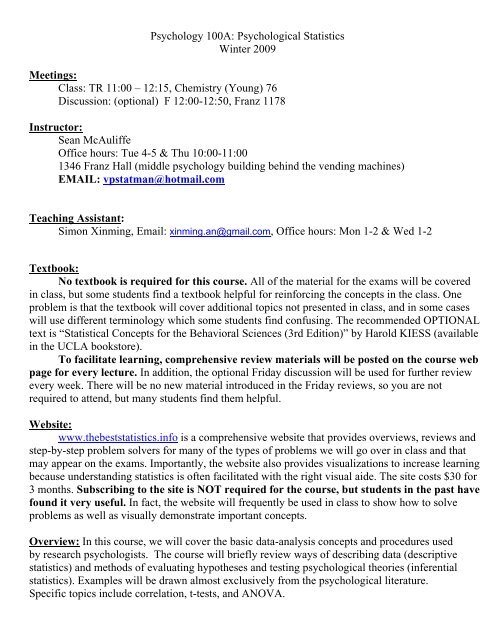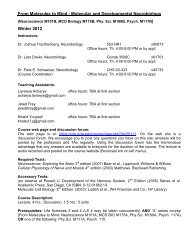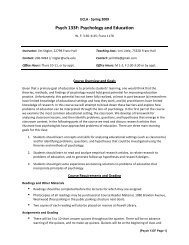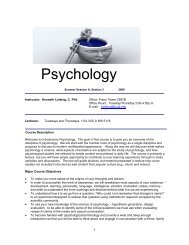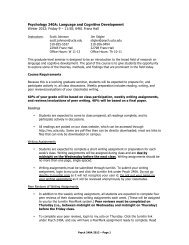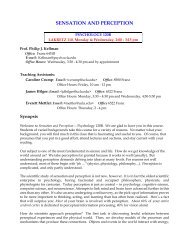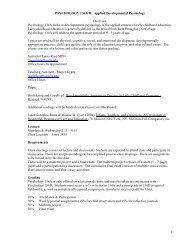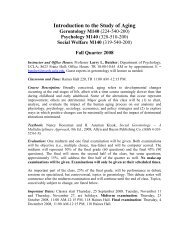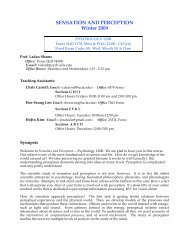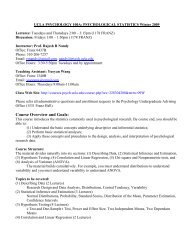Psychological Statistics - Courses in Psychology - UCLA
Psychological Statistics - Courses in Psychology - UCLA
Psychological Statistics - Courses in Psychology - UCLA
You also want an ePaper? Increase the reach of your titles
YUMPU automatically turns print PDFs into web optimized ePapers that Google loves.
<strong>Psychology</strong> 100A: <strong>Psychological</strong> <strong>Statistics</strong>W<strong>in</strong>ter 2009Meet<strong>in</strong>gs:Class: TR 11:00 – 12:15, Chemistry (Young) 76Discussion: (optional) F 12:00-12:50, Franz 1178Instructor:Sean McAuliffeOffice hours: Tue 4-5 & Thu 10:00-11:001346 Franz Hall (middle psychology build<strong>in</strong>g beh<strong>in</strong>d the vend<strong>in</strong>g mach<strong>in</strong>es)EMAIL: vpstatman@hotmail.comTeach<strong>in</strong>g Assistant:Simon X<strong>in</strong>m<strong>in</strong>g, Email: x<strong>in</strong>m<strong>in</strong>g.an@gmail.com, Office hours: Mon 1-2 & Wed 1-2Textbook:No textbook is required for this course. All of the material for the exams will be covered<strong>in</strong> class, but some students f<strong>in</strong>d a textbook helpful for re<strong>in</strong>forc<strong>in</strong>g the concepts <strong>in</strong> the class. Oneproblem is that the textbook will cover additional topics not presented <strong>in</strong> class, and <strong>in</strong> some caseswill use different term<strong>in</strong>ology which some students f<strong>in</strong>d confus<strong>in</strong>g. The recommended OPTIONALtext is “Statistical Concepts for the Behavioral Sciences (3rd Edition)” by Harold KIESS (available<strong>in</strong> the <strong>UCLA</strong> bookstore).To facilitate learn<strong>in</strong>g, comprehensive review materials will be posted on the course webpage for every lecture. In addition, the optional Friday discussion will be used for further reviewevery week. There will be no new material <strong>in</strong>troduced <strong>in</strong> the Friday reviews, so you are notrequired to attend, but many students f<strong>in</strong>d them helpful.Website:www.thebeststatistics.<strong>in</strong>fo is a comprehensive website that provides overviews, reviews andstep-by-step problem solvers for many of the types of problems we will go over <strong>in</strong> class and thatmay appear on the exams. Importantly, the website also provides visualizations to <strong>in</strong>crease learn<strong>in</strong>gbecause understand<strong>in</strong>g statistics is often facilitated with the right visual aide. The site costs $30 for3 months. Subscrib<strong>in</strong>g to the site is NOT required for the course, but students <strong>in</strong> the past havefound it very useful. In fact, the website will frequently be used <strong>in</strong> class to show how to solveproblems as well as visually demonstrate important concepts.Overview: In this course, we will cover the basic data-analysis concepts and procedures usedby research psychologists. The course will briefly review ways of describ<strong>in</strong>g data (descriptivestatistics) and methods of evaluat<strong>in</strong>g hypotheses and test<strong>in</strong>g psychological theories (<strong>in</strong>ferentialstatistics). Examples will be drawn almost exclusively from the psychological literature.Specific topics <strong>in</strong>clude correlation, t-tests, and ANOVA.
Course Requirements and Grad<strong>in</strong>g: It is very important that you attend all classes <strong>in</strong> orderto keep up with the material. Your grade will depend on your performance on the midterms andf<strong>in</strong>al exams. If you miss some lectures and get lost, you will be <strong>in</strong> serious trouble becauseconcepts build on other concepts. <strong>Statistics</strong> is cumulative but the exams emphasize recentmaterials. All exam material will come from lectures.Grad<strong>in</strong>g basis:Midterm 1 (Thu January 29) 30 po<strong>in</strong>ts (30 Fill <strong>in</strong> the blank questions/problems)Midterm 2 (Tue March 03) 30 po<strong>in</strong>ts (30 Fill <strong>in</strong> the blank questions/problems)F<strong>in</strong>al (Fri March 20) 60 po<strong>in</strong>ts (60 Fill <strong>in</strong> the blank questions/problems)As you will learn <strong>in</strong> the course, the distribution of scores can be described <strong>in</strong> a standardizedway. A Z-score is a standardized score which <strong>in</strong>dicates how far a particular score is away fromthe mean (or average) score <strong>in</strong> terms of standard deviations (a measure of how wide adistribution is) Exam scores that are above the mean will have a positive Z-score, exam scoresbelow the mean will have a negative Z-score. Your average Z-score on all the exams willdeterm<strong>in</strong>e your grade The f<strong>in</strong>al exam will count twice as much as the other exams <strong>in</strong> thisaverage. Below is the correspondence between the average Z-score and the grade you willreceive. Next to the Z score is the approximate % of the class that will get that grade.Average Z-score Grade Approximate % of class receiv<strong>in</strong>g score>1.30 A 10>0.85 A- 10>0.55 B+ 10>0.25 B 10>0.00 B- 10>-0.25 C+ 10>-0.85 C 20>-1.30 C- 10>-1.70 D 5
Your grade is up to you. While the course is go<strong>in</strong>g on, I will do as much as I can to make sureyou learn as much as you can about this material. If you want to learn more or you are confused,COME TO OFFICE HOURS I may be ugly, but I am not that scary <strong>in</strong> my office.At the end of every quarter after the f<strong>in</strong>al, there are <strong>in</strong>evitably a handful of students who beg mefor a way to <strong>in</strong>crease their grade because they didn’t seek help when they had the chance. Myanswer to these requests to change grades is always the same – No. No. No. No. No. It would begrossly unfair to all students if I ever allowed anyth<strong>in</strong>g but the scores determ<strong>in</strong>e the grade.Fairness is very important and fairness is the reason why a student will NEVER be able to<strong>in</strong>crease their grade after the course is done.Miss<strong>in</strong>g-Exam: Under certa<strong>in</strong> EXTREME conditions (severe medical illness with completemedical documentation or death of an IMMEDIATE family member), ONE miss<strong>in</strong>g midtermexam can be substituted with the lowest Z-score of the rema<strong>in</strong><strong>in</strong>g exams. In this way, studentswho are consistent good performers need not be hurt by a miss<strong>in</strong>g exam.For example:Exam 1 Z=1.0Exam 2 Miss<strong>in</strong>g due to EXTREME case of EbolaF<strong>in</strong>al Exam Z = 1.2In this case, the miss<strong>in</strong>g exam would be scored as z=1.0 because 1.0 was the lowest z-score ofthe rema<strong>in</strong><strong>in</strong>g exams. In this case, the average z score would be (1.0+1.0+1.2+1.2)/4 = 4.4/4 =1.1 which would be an A-.Miss<strong>in</strong>g the FINAL exam will result <strong>in</strong> an F.Only ONE of the 2 midterm exams can be missed.No <strong>in</strong>completes, extra credit, etc. are given <strong>in</strong> 100A.Exam difficulty: The exams are DIFFICULT The scores are curved so this is really not aproblem. In fact, hard exams are good because they allow the students who know more todist<strong>in</strong>guish themselves from those who don’t know very much An exam that is too easy doesnot allow for a wide enough spread <strong>in</strong> the distribution. Some of the exam questions will besimilar to questions <strong>in</strong> the book or examples done <strong>in</strong> class. Some of the questions will requireyou to understand the concepts well enough to relate them to each other <strong>in</strong> a potentially novelway.Exam Completion: Your answers on the exam will be written on an answer sheet. It is yourresponsibility to have these answers written down by the end of the exam period. Why are wetell<strong>in</strong>g you this? Because if we don’t, some students will wait until the end of the exam totransfer their answers from their exam to the response sheet, which would effectively give themmore time than the other students. That’s simply not fair and it will not be allowed. Whentime runs out dur<strong>in</strong>g the exam, students will not be allowed to write anyth<strong>in</strong>g more on theirresponse sheet.
Why are the exams not multiple choice?: Because multiple choice exams areunfair. They are unfair because they are greatly affected by guess<strong>in</strong>g. The examplebelow shows how random guess<strong>in</strong>g has a dramatic effect on test scores even whenknowledge is equivalent. The dark bars are all students who know 20 out of 30questions and guess on the rest of the questions. The lighter bars are students whoknow 15 out of 20 and guess on the rest. Notice how large the differences are on amultiple choice test between students who have equal knowledge. On a fill-<strong>in</strong> theanswer test, all students who know 15 questions will get a score of 15 and allstudents who knows 20 answers will get a score of 20. In addition, life is not amultiple choice.65432Knows 15Knows 201015(F)16(D)17(C-)18(C )19(C+)20(B-)21(B+)22(A-)23(A)24(A)Cheat<strong>in</strong>g: We hate cheaters and will do everyth<strong>in</strong>g possible to get you kicked out of school ifwe catch you. No kidd<strong>in</strong>g here – cheat<strong>in</strong>g is serious bus<strong>in</strong>ess and if we catch you, then you arehistory. Note – we have had a lot of experience at catch<strong>in</strong>g cheaters, so just don’t do it. Despitewhat you may have heard, <strong>UCLA</strong> will kick you out of school for a couple of semesters (ormore) if you caught cheat<strong>in</strong>g.
Calculator Type:Fairness is very important <strong>in</strong> this class. The only way to be fair is to require thateveryone has EXACTLY the same calculator. Because supplies are often limited, I will br<strong>in</strong>ga supply of calculators to class. The calculator will cost $5. Many students will be annoyed thatthey have to buy a $5 calculator when they already have one, but there is no way of mak<strong>in</strong>g surethat different calculators have the same functionality (we can’t check 150 calculators dur<strong>in</strong>g theexam). Remember, you are not required to buy a textbook, which costs far more than $5.Any other calculators will not be allowed – NO EXCEPTIONS. In fact, you will lose5 po<strong>in</strong>ts on exam if you do not have the official calculator – your unofficial calculator will betaken dur<strong>in</strong>g the exam period and you will be given an official calculator for the exam. 5 po<strong>in</strong>tsis a lot of po<strong>in</strong>ts. Calculators will be available after class throughout the term.Formula Sheets: No formula sheet will be given out for use dur<strong>in</strong>g the exams. Studentsoften compla<strong>in</strong> that memoriz<strong>in</strong>g a bunch of formulas is stupid because it is not conceptual.Unfortunately, this th<strong>in</strong>k<strong>in</strong>g is wrong. As you will learn <strong>in</strong> this course – the formula cannot beseparated from the concept and <strong>in</strong> some cases the formula IS the concept.Schedule:Date Material LectureJan 06 tue Introductory Materials 1Jan 08 thu Central tendency and variability 2Jan 13 tue Normal Distribution 3Sampl<strong>in</strong>g Distributions, ConfidenceJan 15 thu Intervals 4Jan 20 tue Introduction to hypothesis test<strong>in</strong>g 5Jan 22 thu More hypothesis test<strong>in</strong>g 6Jan 27 tue Review for Exam 1Jan 29 thu MIDTERM EXAM 1Feb 03 tue two sample <strong>in</strong>dependent T-tests 7Feb 05 thu two sample dependent T-tests 8Feb 10 tue power, experimental design 9Feb 12 thu Power/one-way ANOVA (between) 10Feb 17 tue one-way ANOVA (between) 11Feb 19 thu one way ANOVA (with<strong>in</strong>) 12Feb 24 tue two-way ANOVA (between) 13Feb 26 thu Review for Exam 2Mar 03 tue MIDTERM EXAM 2Mar 05 thu Correlation 14Mar 10 tue Regression & Chi-square 15Mar 12 thu F<strong>in</strong>al reviewMar 20 Fri FINAL EXAM 11:30-2:30 <strong>in</strong> class


